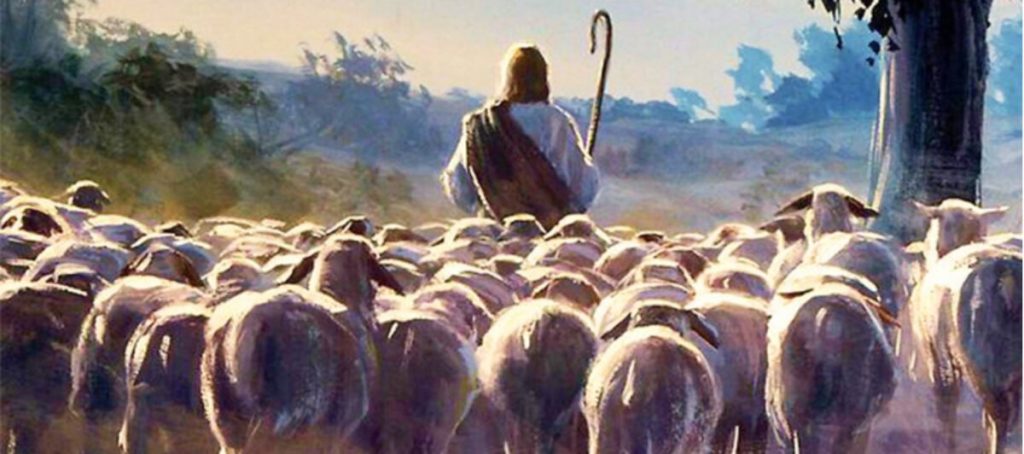Sermon at Joy: Sunday/April 30, 2023
Text: John 10:1-10

In John 10, Jesus describes himself as the good shepherd who lays down his life for his sheep. This metaphorical language is rich with meaning and provides a powerful image of Jesus’ love and care for his followers. Today, we will explore the significance of Jesus as the good shepherd and what it means for us as his sheep.
First, it’s important to understand the context in which Jesus spoke these words. In John 10, Jesus is responding to the Pharisees who were questioning his authority and legitimacy as a teacher. Jesus uses the metaphor of the shepherd and his sheep to illustrate the relationship between himself and his followers. He explains that the sheep know the voice of their shepherd and follow him because they trust him. In the same way, Jesus’ followers know his voice and trust him to lead them.
They have gotten to know him. They have seen his care for those who are hungry as he fed them. They have seen his compassion for the grieving as he stopped to cry with them and then raise their dead. They have seen his mercy as he has touched untouchable lepers and forgiven unforgivable sinners. He is no thief or robber trying to get something from them. He is not even like the Pharisees who are attacking him, who only seem to be concerned about the rules and their own position and not for the people. The people know who Jesus is. He is one of them and he cares for them.
Furthermore, Jesus emphasizes the importance of the shepherd’s role in protecting his sheep. He says that the hired hand who does not own the sheep will run away when he sees a wolf coming, leaving the sheep vulnerable to attack. However, the good shepherd will lay down his life for his sheep, protecting them from harm. This is a powerful image of Jesus’ sacrificial love for his followers. He is willing to give up his own life to protect us from harm and guide us on the right path.
He stood up for people who were being put down by the Pharisees with their smug self-righteousness, he forgave people who were condemning themselves because of their guilt, he spoke out against injustice and oppression, he confronted self-centeredness and selfishness and gathered people together to live out a new way in a kingdom of love and compassion. He forgave people of their sins.
This just drove the authorities into greater frenzy and riled up the powers in spiritual places. Finally, he stood up between us and the alpha wolf himself, the devil, striving with evil and guilt and sin for the soul of the world, not giving up, not letting go his grip, wrestling with sin all the way down into the grave, emerging three days later torn but alive and victorious. And then he came back to his sheep, to those disciples huddled in fear and confusion, to lead them into a new life, to show them they didn’t have to be afraid anymore, not even of death, as they stayed close to him and to each other. He had come that they might have life and have it abundantly, he said. And he gave his life that they might – that we might – be safe and have that life, that love and forgiveness and mutual compassion and courage forever.
Finally, Jesus’ metaphor of the shepherd and his sheep also highlights the intimacy of the relationship between Jesus and his followers. The shepherd knows his sheep by name and they know him.
They are not just a nameless horde or even just numbers in a tally sheet. Even the very hairs on their heads were known to him. He knew a guy, for instance, by the name of Philip and called him by name even before he met him and knew when he was sitting miles away under a fig tree. He knew that a Samaritan woman that he met along a road had had five husbands and that the man she was living with was not her husband. He knew that a woman way across the city square was a widow and that her only child now had died and that her heart was broken. He knew each of the 5000 people that sat in the field with him listening to him about love and compassion and he knew that they were hungry and the Gospel writer says he had compassion on each of them because they were like sheep without a shepherd. He knew them all. He loved them all. And so he fed them, and raised their children, and forgave their sins, and invited them to come along with him and share his life.
In the same way, Jesus knows each of us intimately and calls us by name. He knows our struggles, our fears, and our joys. He is always present with us, alive and risen from the dead, guiding us and comforting us and giving us strength in our times of need. Even as he said after he rose, lo, i am with you always even to the end of the world. He is with us to lead us on now, safely to pasture in heaven.
Jesus’ metaphor of the good shepherd in John 10 is a powerful image of his love and care for his followers. As his sheep, we can trust him to lead us, protect us, and guide us on the right path.
We can take comfort in the knowledge that Jesus knows us intimately and is always present with us. We can be brave even in the face of death knowing that he has destroyed death’s power, opening the way through it to his pasture beyond. We can follow the good shepherd as he calls our name and trust in his love and guidance in our lives.
